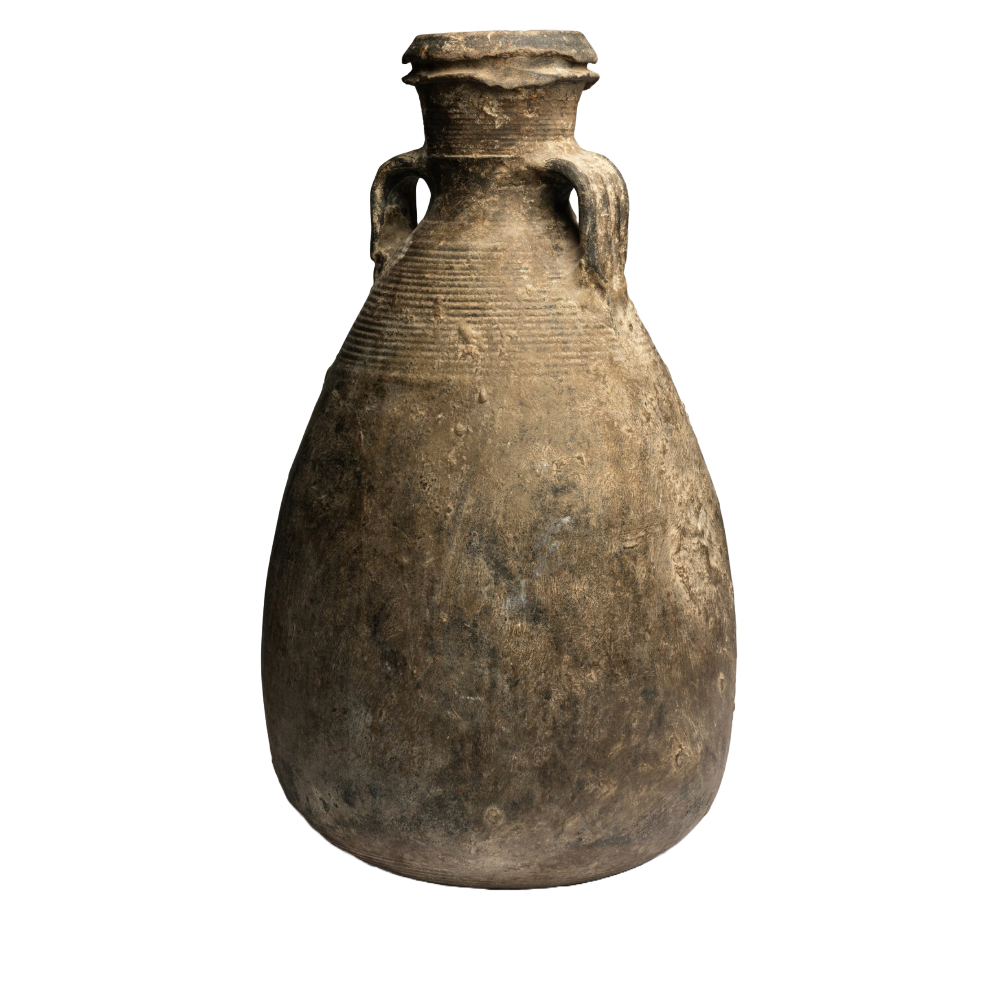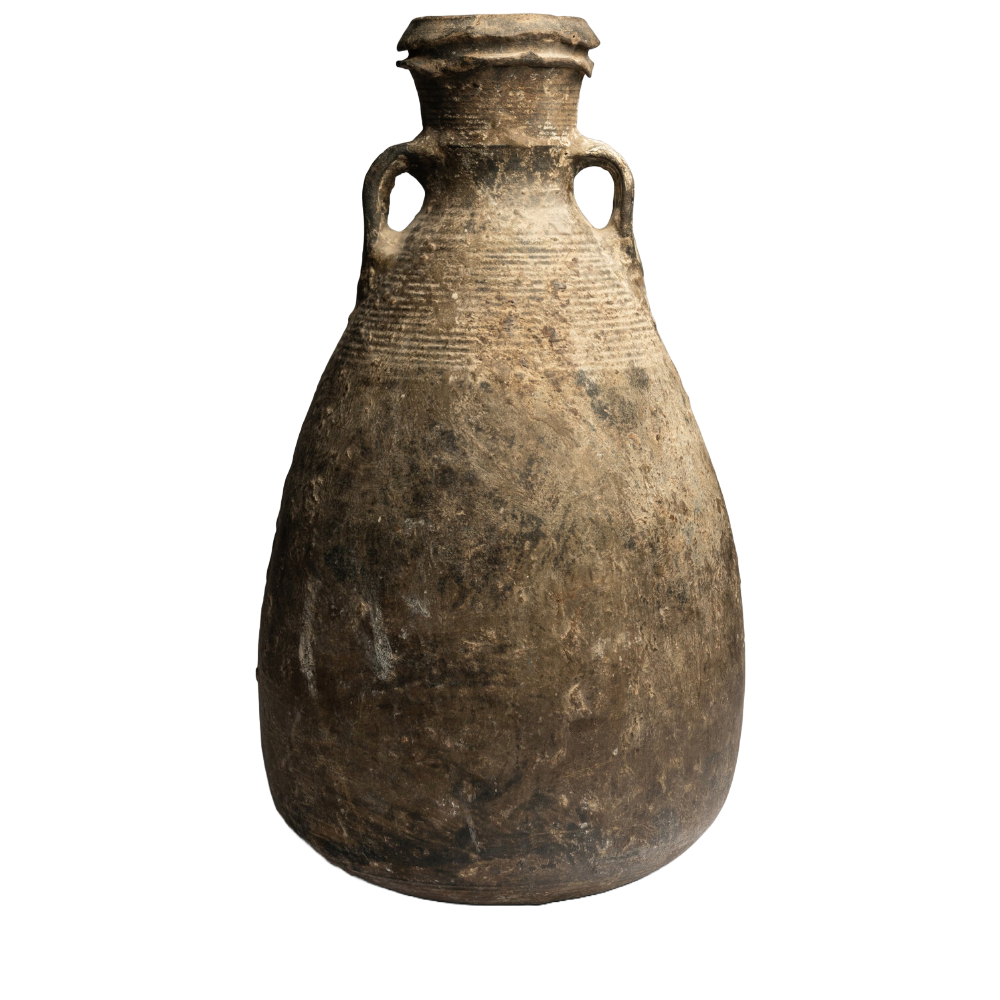 Image 1 of 3
Image 1 of 3

 Image 2 of 3
Image 2 of 3

 Image 3 of 3
Image 3 of 3




Holyland Terracotta Amphora
Circa 1st-6th Century A.D.
This Amphora is featured with 13 finely incised horizontal lines right under the lip, located on the neck. With another 19 carefully carved linear bands in the shoulder region, just below the handles that wrap around the body. Toward the lower body, are about a dozen incised lines that encircle the base.
These larger scale Holyland amphoras are usually made from Terracotta or fired clay, and were often mass-produced using molds or pottery wheels. As they served a very important function in the daily life of the people during this time. They were used for storage and transportation of a variety of different goods, primarily liquids such as water, wine and olive oils. In some cases they were also used to transport and store dry goods such as grain. Amphoras such as this one were extremely prevalent in the Mediterranean regions such as the present day areas of Israel, Palestine and the various surrounding regions, which are usually collectively known as the Holyland. Typically these pieces come in a wide range of shapes and sizes. Amphoras often had either pointed or curved bases, allowing them to be stored upright in racks or pushed into soft ground or sand.
This artifact comes from the esteemed collection of Donald Herman Wonder, a passionate and discerning collector of antiquities whose lifelong interest in ancient civilizations was matched by his dedication to education and the arts. Born in Oakland, California, Wonder earned his degree in music from the University of California, Berkeley, and later became a beloved music educator and private instructor. Alongside his career in music, he cultivated a deep appreciation for archaeology and history, building a respected private collection of ancient artifacts over several decades. His collection, featured pieces from all around the world, including Egyptian, Mediterranean and Near Eastern regions, including the Holy Land. Wonder's legacy as both an educator and antiquarian is evident in the thoughtful care and authenticity of the objects he preserved, each selected not just for its beauty but for its cultural and historical significance.
Circa 1st-6th Century A.D.
This Amphora is featured with 13 finely incised horizontal lines right under the lip, located on the neck. With another 19 carefully carved linear bands in the shoulder region, just below the handles that wrap around the body. Toward the lower body, are about a dozen incised lines that encircle the base.
These larger scale Holyland amphoras are usually made from Terracotta or fired clay, and were often mass-produced using molds or pottery wheels. As they served a very important function in the daily life of the people during this time. They were used for storage and transportation of a variety of different goods, primarily liquids such as water, wine and olive oils. In some cases they were also used to transport and store dry goods such as grain. Amphoras such as this one were extremely prevalent in the Mediterranean regions such as the present day areas of Israel, Palestine and the various surrounding regions, which are usually collectively known as the Holyland. Typically these pieces come in a wide range of shapes and sizes. Amphoras often had either pointed or curved bases, allowing them to be stored upright in racks or pushed into soft ground or sand.
This artifact comes from the esteemed collection of Donald Herman Wonder, a passionate and discerning collector of antiquities whose lifelong interest in ancient civilizations was matched by his dedication to education and the arts. Born in Oakland, California, Wonder earned his degree in music from the University of California, Berkeley, and later became a beloved music educator and private instructor. Alongside his career in music, he cultivated a deep appreciation for archaeology and history, building a respected private collection of ancient artifacts over several decades. His collection, featured pieces from all around the world, including Egyptian, Mediterranean and Near Eastern regions, including the Holy Land. Wonder's legacy as both an educator and antiquarian is evident in the thoughtful care and authenticity of the objects he preserved, each selected not just for its beauty but for its cultural and historical significance.
Height: 21 inches (53.34 cm)
Diameter: 12 Inches (30.48 cm)
Circumference: 38 Inches (96.52 cm)
Mouth/Lid Diameter: 5 Inches (12.7)
Provence: Freeman’s & Hindman, The Wonder Collection of Antiquities and Ancient Art, Part 2: Sale 2102, 16 August 2024, Donald Wonder (1938-2023), California & New Jersey ; Thence by descent.